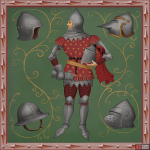Text
In the 14th century, manufacturing capabilities expanded, leading to the production of stronger and often combined armours. Older chainmail armours transitioned to plate armour due to advancements in steel processing and the ability to forge larger pieces of metal on automatic hammers. Soldiers’ heads were protected by helmets such as the cervelliere (known as the “iron hat”), bascinets, and helms. Armours were crafted by armourers or helmet makers, typically from a single piece of hardened plate (skull caps, bascinets) or riveted together from several smaller pieces (cervelliere, sallet). The finest armour of the early 15th century was considered that made in German and Italian lands. “Combined type” armours were used by heavy cavalry - they consisted of chainmail supplemented with plate armour covering the limbs and simpler forms of cuirasses, plate coats, or quilted jackets. Some plate coats and breastplates were equipped with a hook for the knight’s spear. If the armour lacked a hook, the spear was inserted into a slot in the shield, which covered the left arm controlling the reins and the lower part of the helmet. A widely used helmet was the bascinet (sallet) with a distinctly shaped visor nicknamed the “dog snout.” Additionally, iron hats with one or two eye slots are frequently depicted in visual sources. Shoulders were protected either by chainmail sleeves or small pauldrons. An indispensable part of the armour was the shield.


No Comments